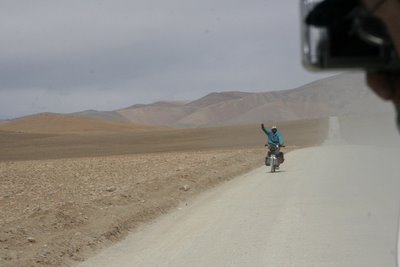Dropping off the end of the world...
 Dish washing with the cow.
Dish washing with the cow. Market place along the roadside
Market place along the roadside Real work men on their way to clear yet another slip
Real work men on their way to clear yet another slip One of many faces from the bus window
One of many faces from the bus window Rice patties
Rice patties A first glimpse of life in Nepal
A first glimpse of life in Nepalwe crossed on foot as the bus was stuck in traffic.
on the Tibetan side of the border.
 The snow ends, and vegetation again begins!
The snow ends, and vegetation again begins!
Tibet lies at an average altitude of 4300 m, in the shadow of the Himalayas, this makes it extremely dry, barren and cold. After crossing a pass at 5200 m, the road plummets to Kathmandu at an altitude of just 1340 m. The change in landscape is indescribable! Nepal is a tropical lowland covered in Banana palms, rice patties, monkeys and people everywhere. The pictures show the contrast!
So far the Chinese have not managed to tame this incredible valley! The ride from the
Guard rails have not yet been invented here!
 The snow ends, and vegetation again begins!
The snow ends, and vegetation again begins!before dropping into Nepal.
on the last pass on the plateau
Tibet lies at an average altitude of 4300 m, in the shadow of the Himalayas, this makes it extremely dry, barren and cold. After crossing a pass at 5200 m, the road plummets to Kathmandu at an altitude of just 1340 m. The change in landscape is indescribable! Nepal is a tropical lowland covered in Banana palms, rice patties, monkeys and people everywhere. The pictures show the contrast!
So far the Chinese have not managed to tame this incredible valley! The ride from the
plateau to the lowlands, a trip of less than 200 km, takes more than 12 hours!














































